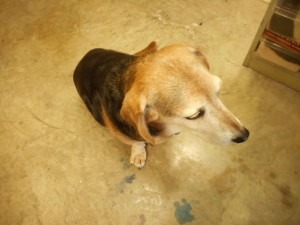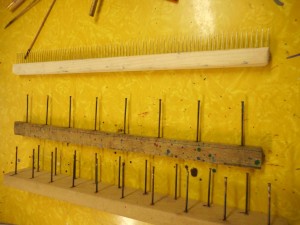In a previous blog, I talked about the marbling workshop on April 22nd. It was a great success and I was pleased to have participants so excited about marbling. In fact, everyone came back for an Open Studio session. In spite of being able to produce a sheet of marbled paper in a 15 minute “make it and take it”, marbling really does take a few days to begin to be in control. I love it when people enjoy something enough to be willing to put more time into learning the craft. I also enjoy the Open Studio idea, where I can work with people without a formal structure. What follows is a lot of photos and brief comments on the workshop. Photos are thanks to Julia Hardy, who became my assistant for this class.
In the few days before the workshop, I stumbled through a bit of a nightmare of logistics. In the space of three days, the class went from six participants to five to four, up to six again and then back to four. Workshops are not like lectures where you can just add a couple of extra chairs. Marbling stations have to be set up with tools, paint, trays and carrageenan. Space is tight in my studio and six participants, plus a demonstration table for me was an interesting problem in spatial design. I had everything set up for six, when I heard there would only be four. This was just the day before the class and too late to unmake the paints or size. Plenty of supplies for the following week of marbling!
- The Studio, the night before
- Paints at the ready
- Throwing stones with the whisk
- Get-gel with a stylus
- Get-gel with a stylus
- Get-gel with a stylus
In marbling, there are always alternative ways of doing most everything. I started by demonstrating how to put paint on the carrageenan size with a whisk and by using an eyedropper. Just to confuse everyone, I also showed how to make the get-gel pattern with a stylus and then with rakes. Each type of pattern was printed for reference. The class went right to work, preparing the paper, throwing paint, creating marbled patterns and printing them.
- Alumming paper
- Alumming paper
- Dropping paint
- Dropping paint
- Dropping paint
- Creating the pattern
- Creating the pattern
- Finished pattern
- Laying down the paper
- Washing
- Drying
- Choosing new paint
- Mixing paint
- Examining marbled papers
Before breaking for lunch, we examined all the wonderful paper that was drying, seeing what worked and where there were problems. I was very pleased with what was accomplished in just a few hours. By the end of the day, great papers were being produced.
- Same colors, varied patterns
- Explaining patterns
- Explaining patterns
- Maps and printed materials
- Marbling over watercolor paintings
- Overmarbling & masking
- Overmarbling
By mid-afternoon we needed a break and looked at different types of patterns, overmarbling and marbling on printed paper. I hope the students were inspired to keep thinking about new ways to look at marbling.
Great class, fun time, all supervised by my assistant, Lucy.

Lucy, marbling supervisor
Saturday and Sunday were Open Studio days and I marbled along with the students. Since then, I’ve been trying to use up as much of the paint and carrageenan as possible and have been playing as well as cleaning up. I can’t believe how long that takes! My studio is slowly transforming itself back into a book workshop and my marbling space is getting back into its usual configuration. I’ve already heard from people that want me to have another workshop, maybe in July or August if my supervisor approves.


















































































































































































































